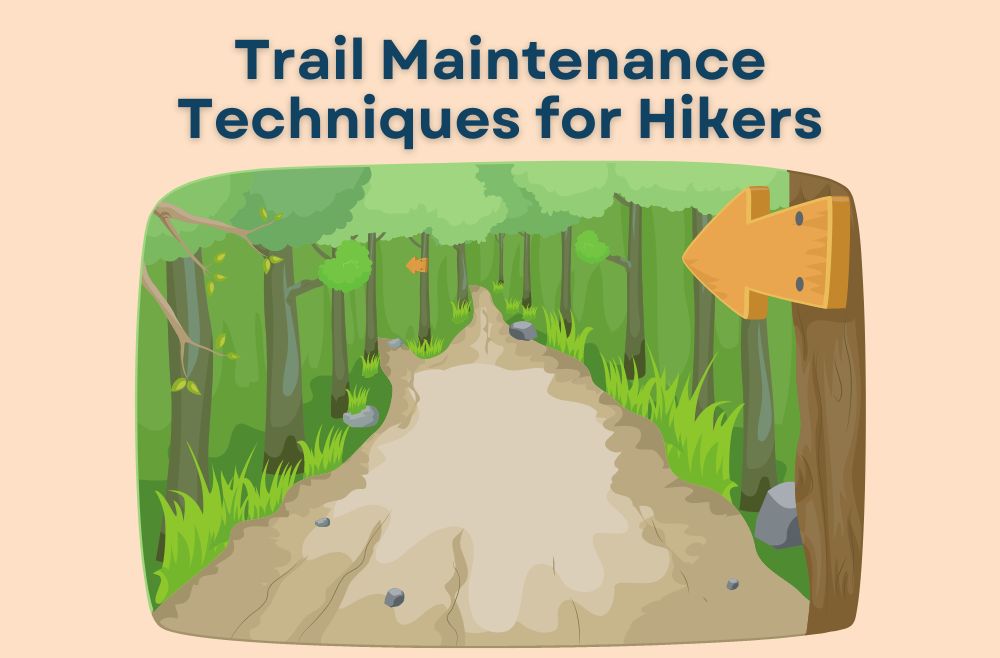Learn essential trail maintenance techniques and tools for hikers. Discover how you can volunteer to maintain hiking trails and be respectful while hiking.
Hiking trails offer a unique opportunity for adventure, exploration, and a deep connection with nature. As hikers, we’re drawn to these pathways that wind through forests, ascend rugged mountains, and unveil the wonders of our natural world.
Yet, the very trails we cherish require ongoing care and maintenance to remain safe, accessible, and enjoyable. In this comprehensive guide, we’ll explore the world of Trail Maintenance Techniques for Hikers and discover how you can play a vital role in preserving the beauty of hiking trails.
This post contains some affiliate links to products that I use and love. If you click through and make a purchase, I’ll earn a commission, at no additional cost to you. Read my full disclosure here.
In This Article
Trail Maintenance Techniques For Hikers
Think About It: Imagine yourself deep in a pristine forest, surrounded by towering trees, the only sound being the gentle rustling of leaves in the breeze. The hiking trail you’re on feels like an ancient path, inviting you to explore its mysteries. But have you ever wondered how it stays so inviting? The answer lies in trail maintenance.
Hiking trails, while they may seem timeless, need regular upkeep to remain safe and accessible. Trail maintenance is the unsung hero that ensures these paths stay in top condition for everyone to enjoy.
In this article, we’ll delve into the world of trail maintenance techniques specifically tailored for hikers. By the end, you’ll not only grasp the importance of trail maintenance but also have the knowledge and tools to actively contribute to the preservation of these outdoor treasures.
Understanding Trail Maintenance
Trail maintenance encompasses a range of activities aimed at keeping hiking trails safe, sustainable, and enjoyable. It’s about ensuring these pathways continue to provide incredible experiences for generations to come. Here’s why it matters:
- Preservation of Natural Resources: Well-maintained trails help protect ecosystems by controlling erosion, preventing the spread of invasive species, and preserving wildlife habitats.
- Safety: Regular maintenance mitigates hazards like loose rocks, fallen trees, and uneven terrain, making hiking safer for all.
- Accessibility: Maintained trails are accessible to people of all ages and abilities, promoting inclusivity and outdoor recreation.
Common Trail Maintenance Challenges
Maintaining hiking trails is not always a walk in the park. Hikers often encounter issues like erosion, overgrowth, and debris along the trails. Here are some of the most common challenges:
- Erosion: Rainwater runoff can erode the trail’s surface, creating ruts and gullies that make hiking uncomfortable and potentially dangerous.
- Overgrowth: Vegetation along the sides of the trail can encroach on the pathway, narrowing the passage for hikers.
- Debris: Fallen branches, rocks, and litter can obstruct the trail, requiring clearance for safe passage.
- Safety Hazards: Fallen trees, unstable rocks, and loose soil pose risks to hikers and need attention to prevent accidents.
- Litter: Trash left behind by careless hikers disrupts the natural beauty of the trail and can harm wildlife.
Essential Trail Maintenance Tools and Equipment
Before we dive into the techniques, it’s essential to familiarize ourselves with the tools and equipment you’ll need for effective trail maintenance. The right gear not only ensures your safety but also makes the job more efficient. Here’s a list of essential tools:
- Trail Maintenance Kit: A basic kit includes a compact saw, pruning shears, a collapsible shovel, and work gloves.
- Rakes and McLeods: These are used for moving dirt and gravel, leveling surfaces, and removing debris from the trail.
- Trail Building Tools: Picks, mattocks, and rock bars are essential for constructing or repairing trails.
- Safety Gear: Helmets, safety glasses, and protective clothing should be worn when using tools.
- First Aid Kit: Always carry a well-equipped first aid kit in case of accidents or injuries.
- Communication Devices: Cell phones or radios are crucial for emergencies and staying in touch with your team.
- Backpack: A comfortable and durable backpack is necessary to carry your gear.
- Navigation Tools: Maps, compasses, or GPS devices are vital for finding your way on the trail.
Basic Trail Maintenance Techniques
Now that you’re equipped with the necessary tools and understand why trail maintenance is essential, let’s explore some fundamental techniques hikers can use to keep their favorite paths in excellent condition.
Clearing Debris and Fallen Branches
One of the most common trail maintenance tasks is clearing debris and fallen branches…
Repairing Erosion Damage
Erosion is a significant threat to hiking trails, especially on slopes and in areas with heavy rainfall. To combat erosion:
- Grade Reversals: Construct grade reversals or water bars to redirect water off the trail and prevent it from eroding the path. These structures help water flow safely alongside the trail.
- Surface Maintenance: Regularly check for eroded areas and repair them by restoring the trail’s surface. This may involve adding fresh gravel or soil to fill in gaps and create a stable walking surface.
Trail Rerouting
In some cases, rerouting a trail may be necessary to avoid sensitive habitats or areas prone to erosion. When rerouting a trail:
- Designate a New Path: Identify a suitable, sustainable route that minimizes environmental impact. Consider the terrain and vegetation carefully.
- Block the Old Path: To discourage hikers from using the old, eroded path, block it with logs or branches. Over time, vegetation will naturally reclaim the old trail.
Sustainable Trail Building Techniques
If you’re passionate about trail maintenance and want to take your skills to the next level, consider learning about sustainable trail building. These advanced techniques focus on designing and constructing trails that minimize environmental impact and promote long-term sustainability.
Organizations like the Appalachian Trail Conservancy offer training and resources for those interested in trail building.
Safety Considerations
Safety should always be a top priority when engaging in trail maintenance activities. Here are some essential safety considerations:
- Working in Groups: Whenever possible, work in a group. Having others around can provide assistance in case of emergencies.
- Proper Training: If you’re new to trail maintenance, seek training and guidance from experienced individuals or organizations.
- Protective Gear: Always wear the appropriate safety gear, including helmets, safety glasses, gloves, and sturdy footwear.
- First Aid: Carry a well-equipped first aid kit and know how to use it.
- Communication: Have reliable communication devices, such as cell phones or radios, for emergencies.
Additional Resources
Join Trail Maintenance Organizations
Consider joining trail maintenance organizations or groups dedicated to preserving hiking trails. These organizations often provide training, tools, and opportunities to volunteer your time and expertise. Some notable organizations include:
Explore Public Lands
Many hiking trails are located on public lands managed by agencies like the National Park Service (NPS), U.S. Forest Service (USFS), and Bureau of Land Management (BLM). These agencies often welcome volunteers and offer valuable resources for those interested in trail maintenance. Check their websites or local offices for more information.
Leave No Trace Principles
Familiarize yourself with the Leave No Trace principles, which emphasize responsible outdoor ethics. By following these guidelines, you can minimize your impact on hiking trails and the surrounding environment, ultimately reducing the need for extensive trail maintenance.
What’s Next?
Trail maintenance is not only essential for keeping hiking trails safe and accessible but also a rewarding way for hikers to give back to the natural world that provides so much joy. Whether you’re clearing fallen branches, repairing erosion damage, or even learning sustainable trail building techniques, your efforts make a significant difference.
Remember, as a hiker, you are not just a visitor but also a steward of these magnificent outdoor spaces. By understanding and practicing trail maintenance, you help ensure that future generations can continue to enjoy the beauty and wonder of hiking trails across the U.S. and beyond.
So, the next time you hit the trail, carry with you not only your love for hiking but also the knowledge and commitment to help maintain it for others to discover and cherish.
Now, get out there and make a positive impact on the hiking trails you love!
FAQ on Hiking Trail Maintenance
What is basic trail building?
Trail building involves the construction and maintenance of trails, usually for recreational purposes. This includes tasks such as clearing away debris, establishing drainage systems, creating switchbacks, and installing safety features such as guardrails. Trail building also includes the installation of bridges and other structures to provide safe passage over water or other obstacles.
What damages trails?
Trails can be damaged by weather, animal activity, and human impact. Erosion can be caused by water runoff or heavy use of trails without proper maintenance. Unsustainable practices like cutting switchbacks or taking shortcuts off trails can also cause damage.
What essential trail repair work should be done?
A: Essential trail repair work includes stabilizing soil erosion, clearing vegetation from existing trails, replacing broken signs or guardrails, and repairing any damaged structures like bridges or retaining walls. It’s important to consider the environment when doing this type of work in order to minimize your impact on wildlife and surrounding habitats.
Who are trail users?
Trail users are those who enjoy using trails for recreational activities like hiking, biking, horseback riding, etc. They are responsible for respecting local regulations regarding off-trail hiking and camping in order to help keep trails safe and accessible for all visitors.
Who are trail crews?
Trail crews are volunteer groups that work together to maintain existing trails or build new ones from scratch. These volunteers typically have knowledge about sustainable trail building techniques and safety protocols in order to ensure a successful project that protects both the environment and future generations of outdoor enthusiasts.
What is the Leave No Trace principle?
The Leave No Trace principles are a set of guidelines that emphasize responsible outdoor ethics and practices when enjoying the outdoors. These principles help to minimize one’s impact on the environment, reduce the need for trail maintenance, and ensure that future generations can continue to enjoy these outdoor spaces.
What are some good trail maintenance techniques?
Good trail maintenance includes clearing fallen branches, repairing erosion damage, and sustainable trail building techniques. Additionally, respecting local regulations regarding off-trail hiking and camping is important in keeping trails safe and accessible.
- McDougall, Len (Author)
- English (Publication Language)




We are participants in the Amazon Services LLC Associates Program, an affiliate advertising program designed to provide a means for sites to earn advertising fees by advertising and linking to Amazon.com